Презентація на тему «Harriet Beecher Stowe»
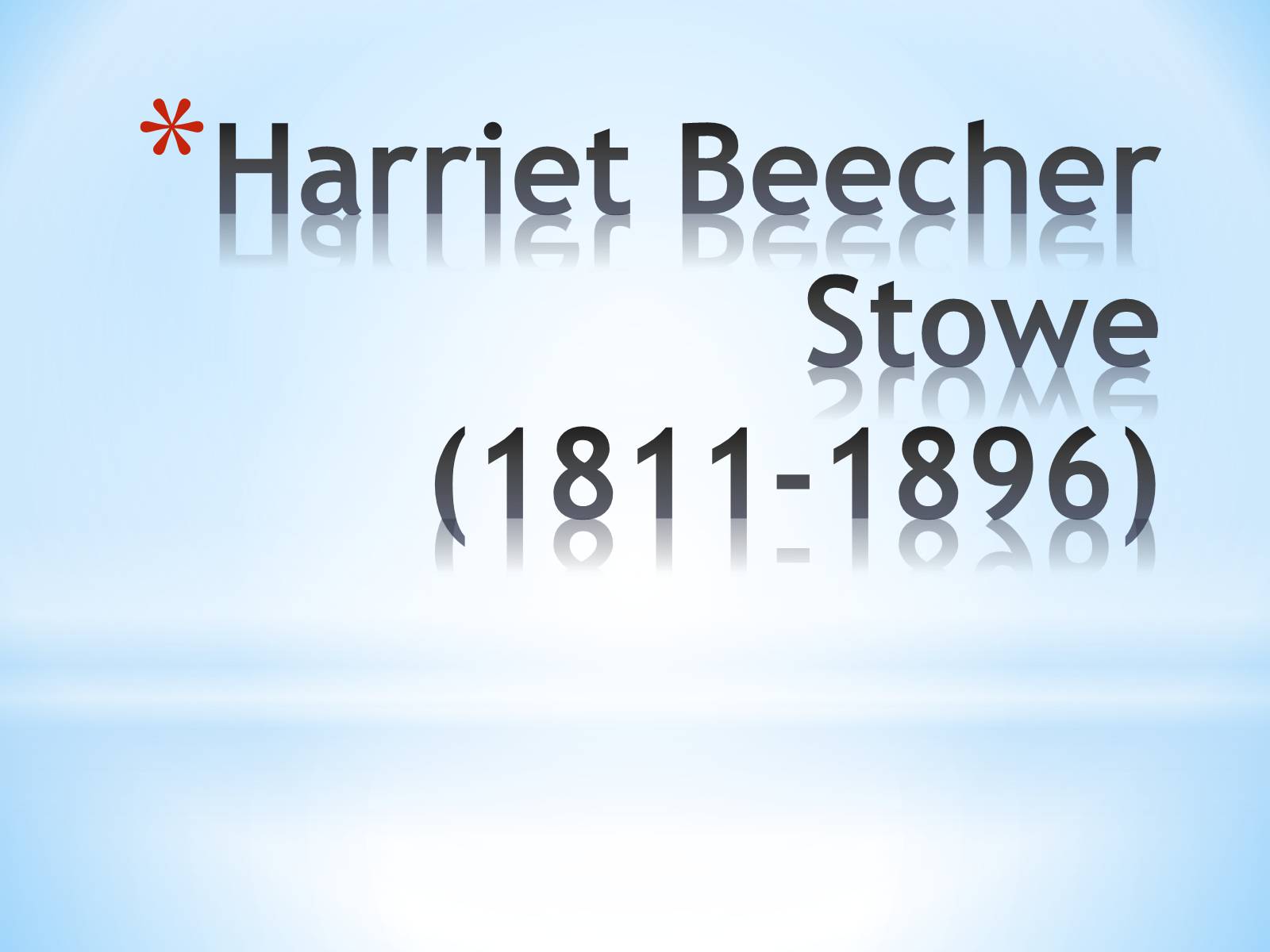
Harriet Beecher Stowe (1811-1896)
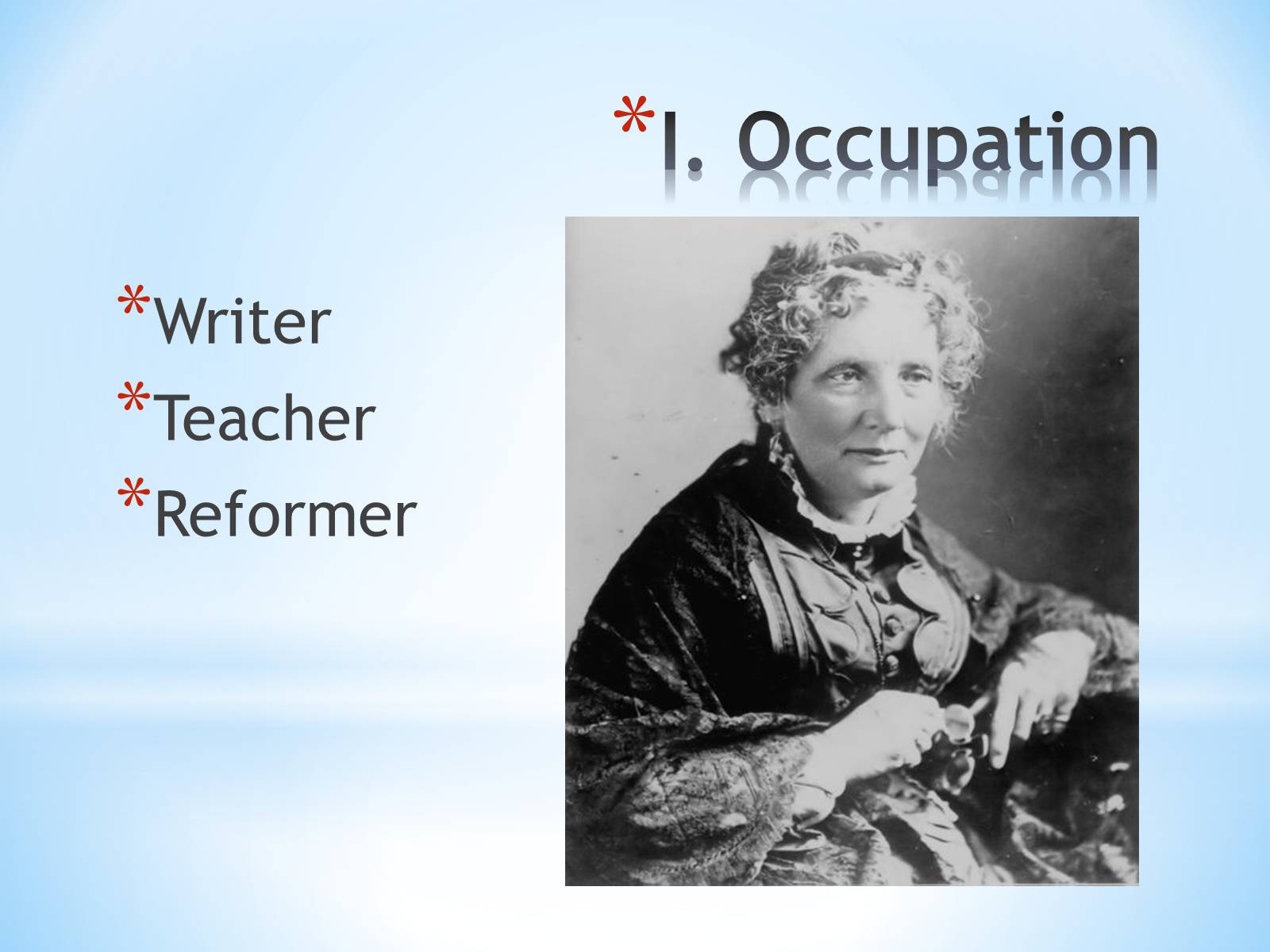
I. Occupation
Writer
Teacher
Reformer

II. Known for
author of Uncle Tom's Cabin, a book which helped build anti-slavery sentiment in America and abroad

III. Family:
Harriet Beecher Stowe was the seventh child of Lyman Beecher and his first wife Roxana.
Father: Lyman Beecher (famous Congregationalist minister; president, Lane Theological Seminary, Cincinnati, Ohio)
Mother: Roxana Foote Beecher (granddaughter of General Andrew Ward; "mill girl" before marriage; died when Harriet was four)
brothers William Beecher, Edward Beecher, George Beecher, Henry Ward Beecher, Charles Beecher and half-brothers Thomas Beecher and James Beecher (five became ministers)
sisters Catherine Beecher and Mary Beecher, half-sister Isabella Beecher Hooker
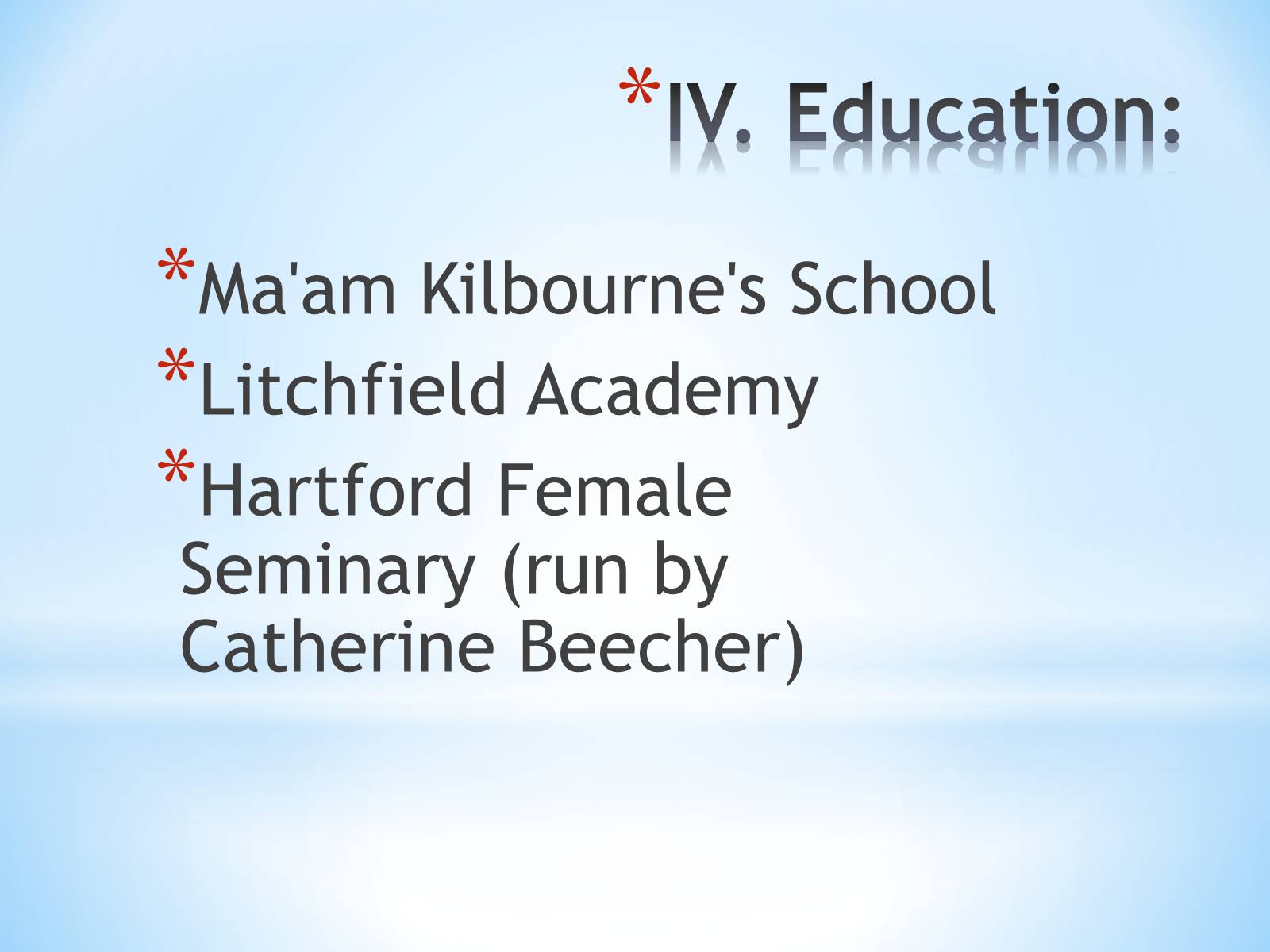
IV. Education:
Ma'am Kilbourne's School
Litchfield Academy
Hartford Female Seminary (run by Catherine Beecher)
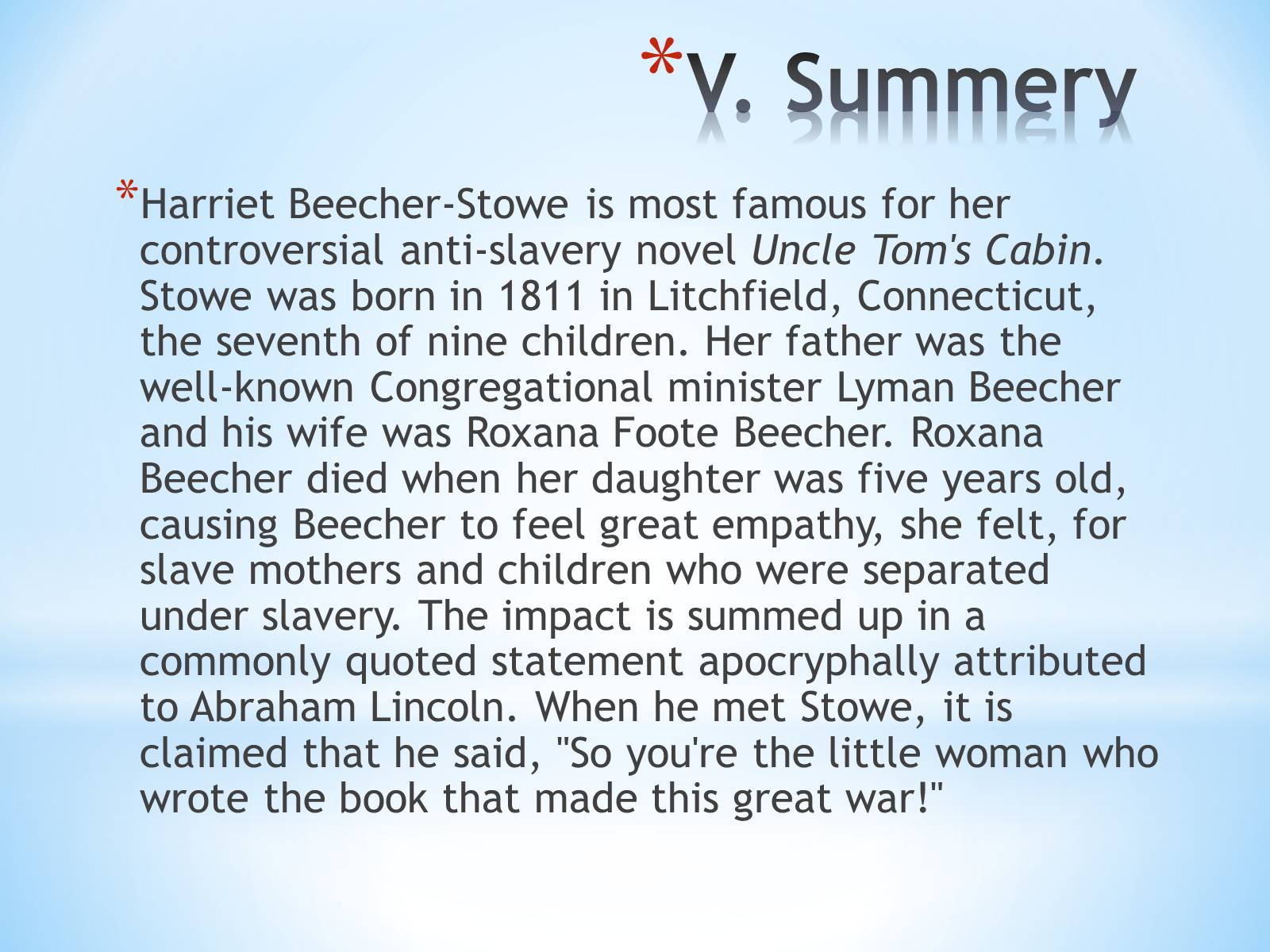
V. Summery
Harriet Beecher-Stowe is most famous for her controversial anti-slavery novel Uncle Tom's Cabin. Stowe was born in 1811 in Litchfield, Connecticut, the seventh of nine children. Her father was the well-known Congregational minister Lyman Beecher and his wife was Roxana Foote Beecher. Roxana Beecher died when her daughter was five years old, causing Beecher to feel great empathy, she felt, for slave mothers and children who were separated under slavery. The impact is summed up in a commonly quoted statement apocryphally attributed to Abraham Lincoln. When he met Stowe, it is claimed that he said, "So you're the little woman who wrote the book that made this great war!"
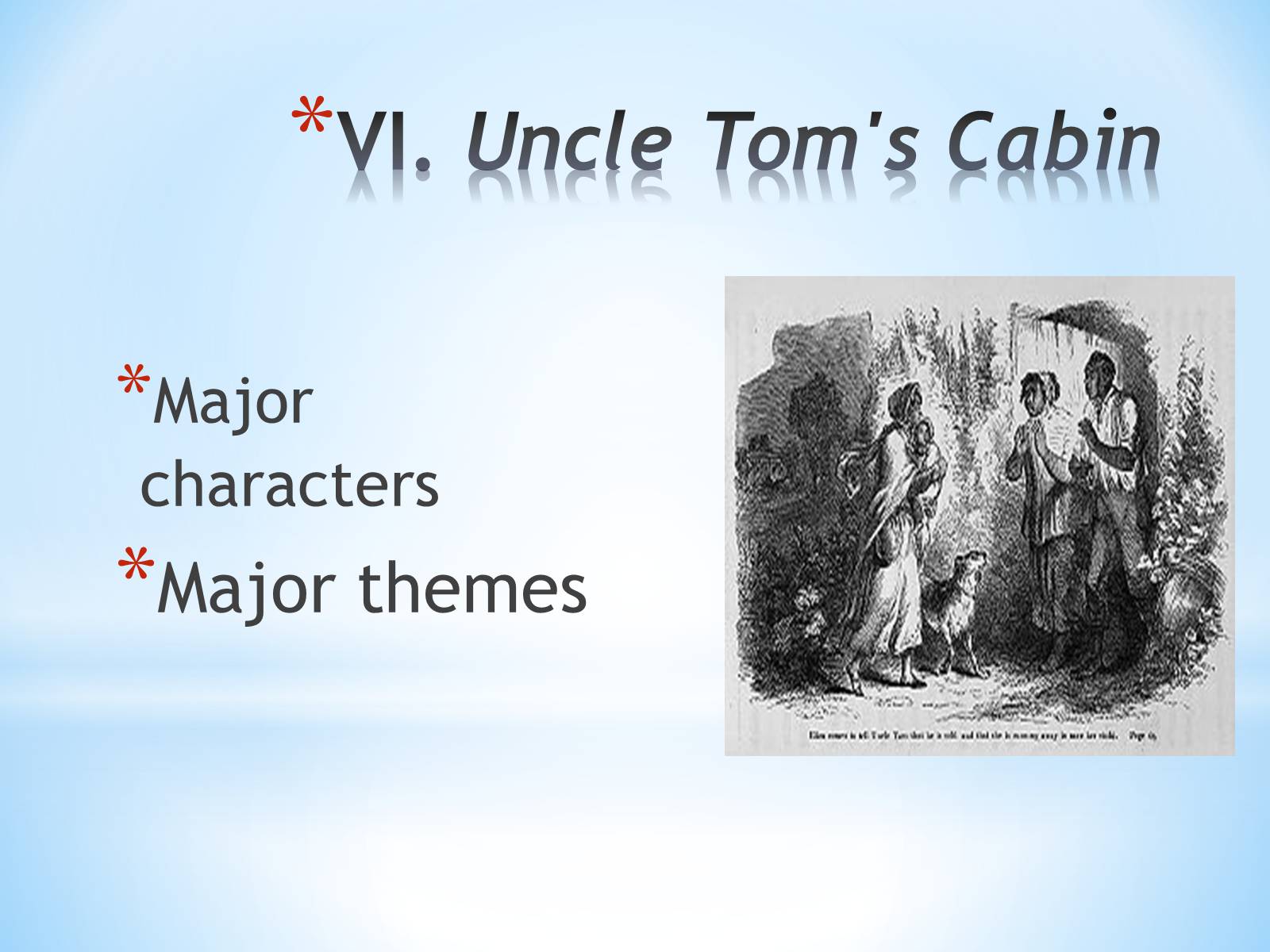
VI. Uncle Tom's Cabin
Major characters
Major themes

Major characters
Uncle Tom
Eliza
Eva
Simon Legree
Topsy
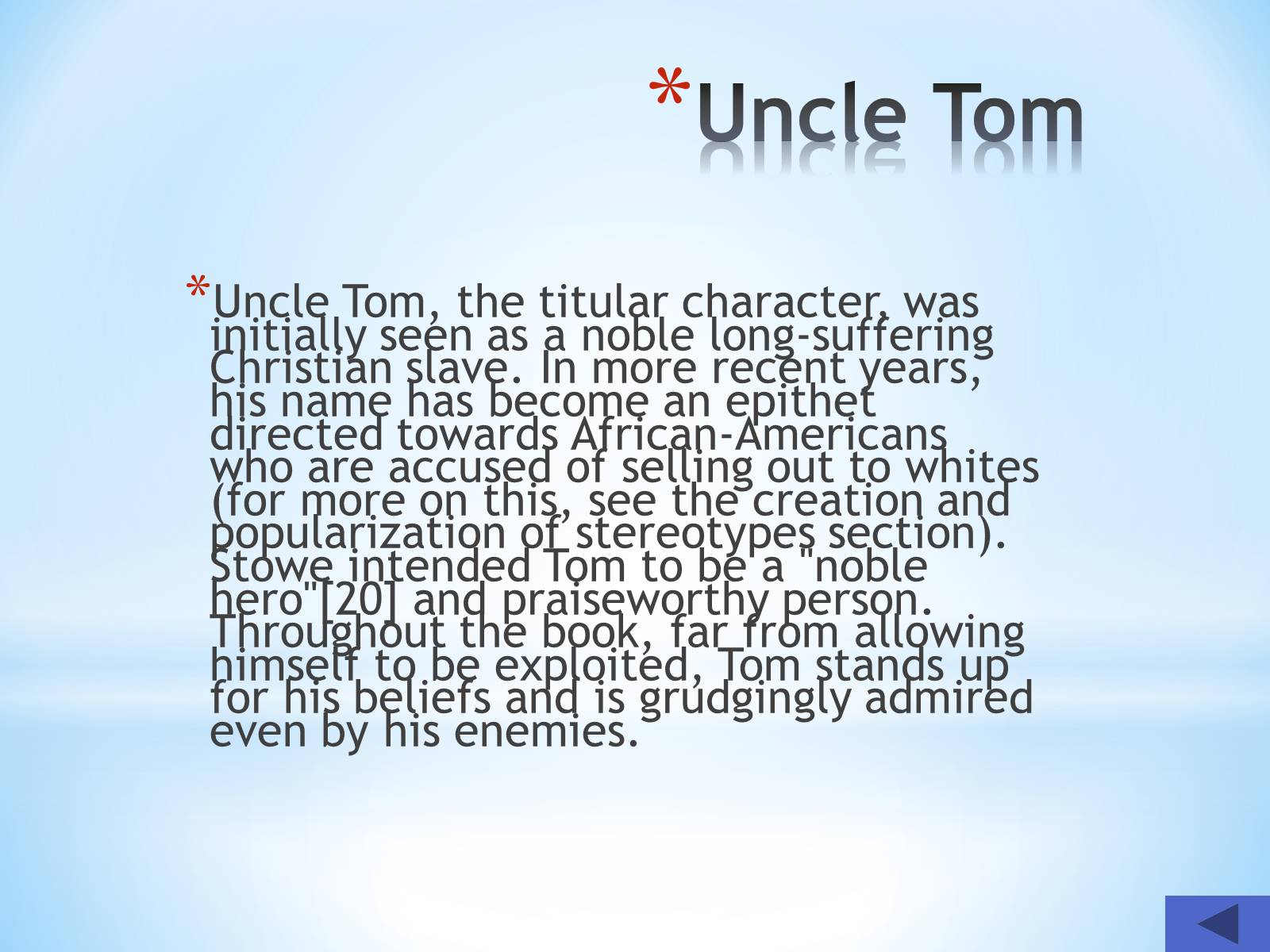
Uncle Tom
Uncle Tom, the titular character, was initially seen as a noble long-suffering Christian slave. In more recent years, his name has become an epithet directed towards African-Americans who are accused of selling out to whites (for more on this, see the creation and popularization of stereotypes section). Stowe intended Tom to be a "noble hero"[20] and praiseworthy person. Throughout the book, far from allowing himself to be exploited, Tom stands up for his beliefs and is grudgingly admired even by his enemies.

Eliza
A slave (personal maid to Mrs. Shelby), she escapes to the North with her five-year old son Harry after he is sold to Mr. Haley. Her husband, George, eventually finds Eliza and Harry in Ohio, and emigrates with them to Canada, then France and finally Liberia.
The character Eliza was inspired by an account given at Lane Theological Seminary in Cincinnati by John Rankin to Stowe's husband Calvin, a professor at the school. According to Rankin, in February, 1838 a young slave woman had escaped across the frozen Ohio River to the town of Ripley with her child in her arms and stayed at his house on her way further north.

Eva
Eva, whose real name is Evangeline St. Clare, is the daughter of Augustine St. Clare. Eva enters the narrative when Uncle Tom is traveling via steamship to New Orleans to be sold, and he rescues the 5 or 6 year-old girl from drowning. Eva begs her father to buy Tom, and he becomes the head coachman at the St. Clare plantation. He spends most of his time with the angelic Eva, however.
Eva constantly talks about love and forgiveness, even convincing the dour slave girl Topsy that she deserves love. She even manages to touch the heart of her sour aunt, Ophelia. Some consider Eva to be a prototype of the character archetype known as the Mary Sue.
Eventually Eva falls ill. Before dying, she gives a lock of her hair to each of the slaves, telling them that they must become Christians so that they may see each other in Heaven. On her deathbed, she convinces her father to free Tom, but because of circumstances the promise never materializes.
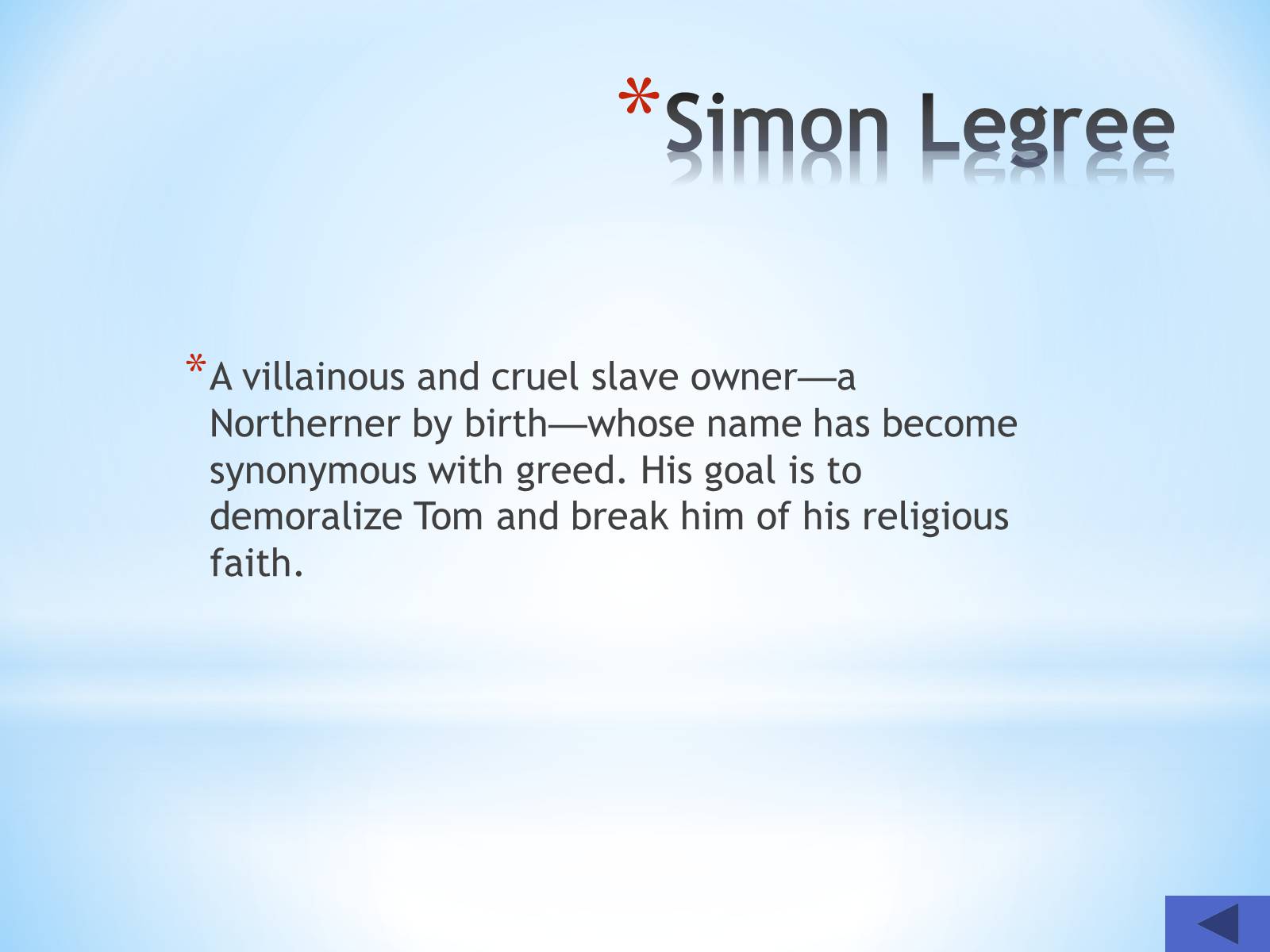
Simon Legree
A villainous and cruel slave owner—a Northerner by birth—whose name has become synonymous with greed. His goal is to demoralize Tom and break him of his religious faith.
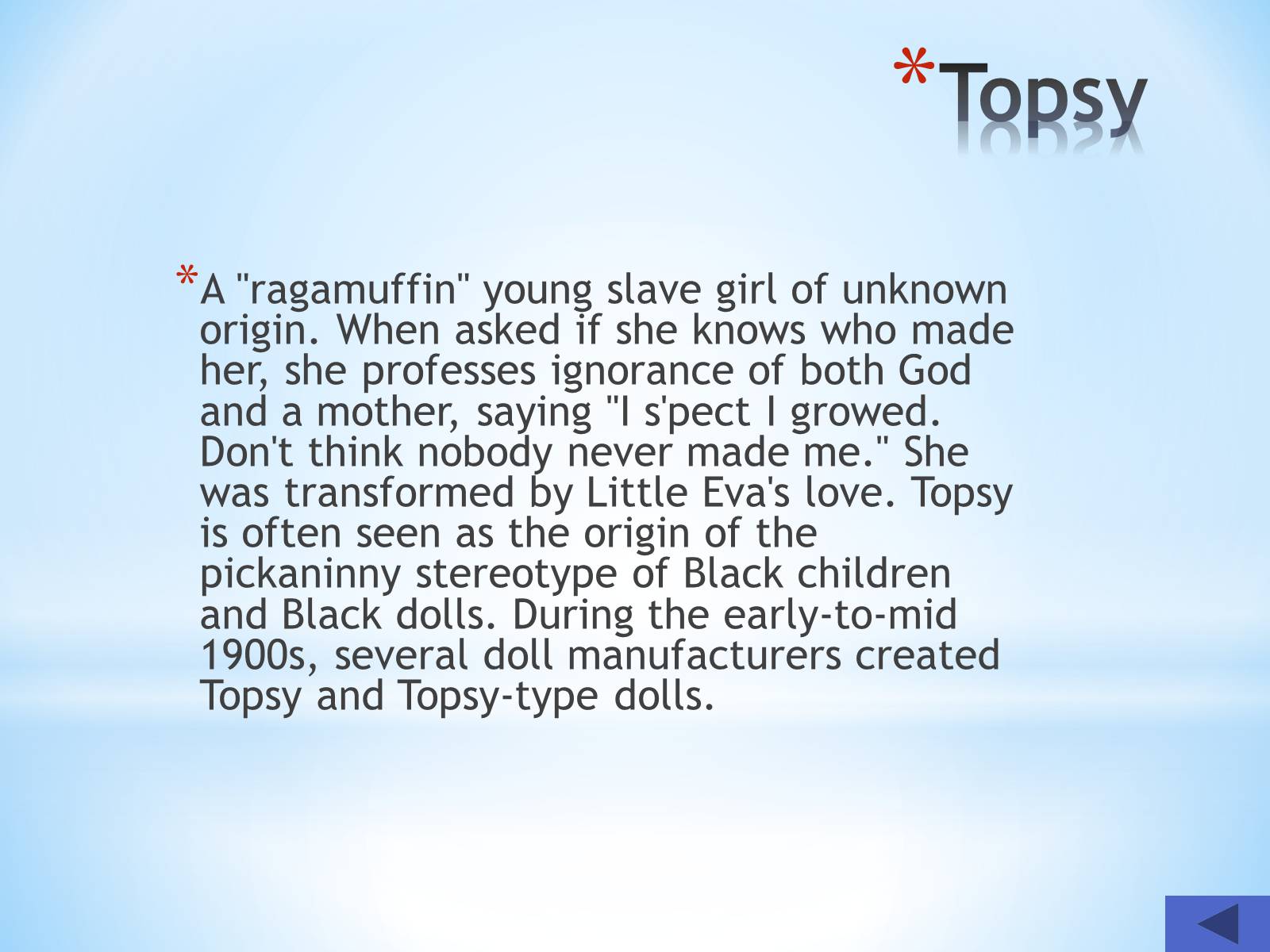
Topsy
A "ragamuffin" young slave girl of unknown origin. When asked if she knows who made her, she professes ignorance of both God and a mother, saying "I s'pect I growed. Don't think nobody never made me." She was transformed by Little Eva's love. Topsy is often seen as the origin of the pickaninny stereotype of Black children and Black dolls. During the early-to-mid 1900s, several doll manufacturers created Topsy and Topsy-type dolls.

Major themes
The Evil of Slavery
The Incompatibility of Slavery & Christian Values
The Moral Power of Women
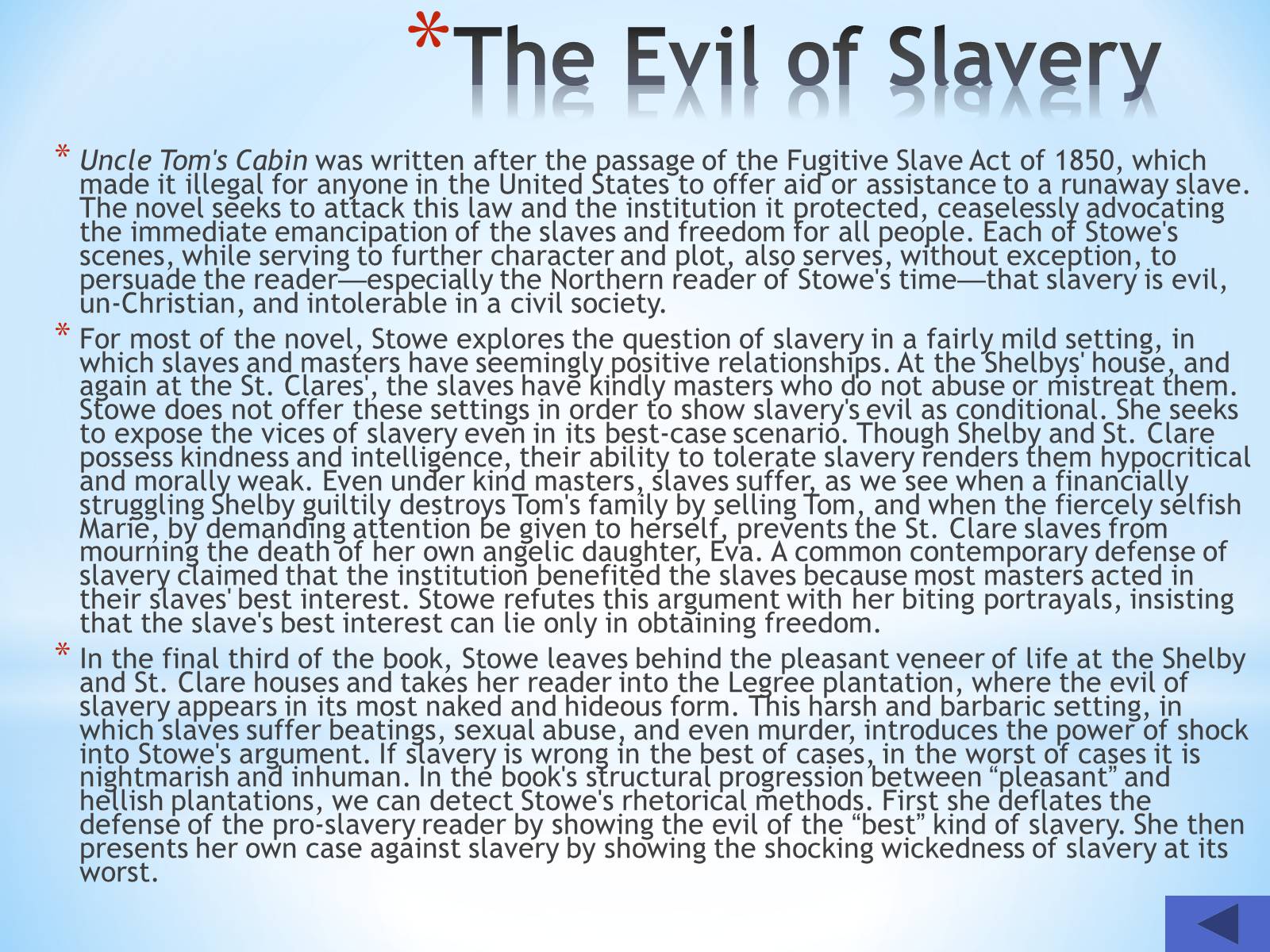
The Evil of Slavery
Uncle Tom's Cabin was written after the passage of the Fugitive Slave Act of 1850, which made it illegal for anyone in the United States to offer aid or assistance to a runaway slave. The novel seeks to attack this law and the institution it protected, ceaselessly advocating the immediate emancipation of the slaves and freedom for all people. Each of Stowe's scenes, while serving to further character and plot, also serves, without exception, to persuade the reader—especially the Northern reader of Stowe's time—that slavery is evil, un-Christian, and intolerable in a civil society.
For most of the novel, Stowe explores the question of slavery in a fairly mild setting, in which slaves and masters have seemingly positive relationships. At the Shelbys' house, and again at the St. Clares', the slaves have kindly masters who do not abuse or mistreat them. Stowe does not offer these settings in order to show slavery's evil as conditional. She seeks to expose the vices of slavery even in its best-case scenario. Though Shelby and St. Clare possess kindness and intelligence, their ability to tolerate slavery renders them hypocritical and morally weak. Even under kind masters, slaves suffer, as we see when a financially struggling Shelby guiltily destroys Tom's family by selling Tom, and when the fiercely selfish Marie, by demanding attention be given to herself, prevents the St. Clare slaves from mourning the death of her own angelic daughter, Eva. A common contemporary defense of slavery claimed that the institution benefited the slaves because most masters acted in their slaves' best interest. Stowe refutes this argument with her biting portrayals, insisting that the slave's best interest can lie only in obtaining freedom.
In the final third of the book, Stowe leaves behind the pleasant veneer of life at the Shelby and St. Clare houses and takes her reader into the Legree plantation, where the evil of slavery appears in its most naked and hideous form. This harsh and barbaric setting, in which slaves suffer beatings, sexual abuse, and even murder, introduces the power of shock into Stowe's argument. If slavery is wrong in the best of cases, in the worst of cases it is nightmarish and inhuman. In the book's structural progression between “pleasant” and hellish plantations, we can detect Stowe's rhetorical methods. First she deflates the defense of the pro-slavery reader by showing the evil of the “best” kind of slavery. She then presents her own case against slavery by showing the shocking wickedness of slavery at its worst.